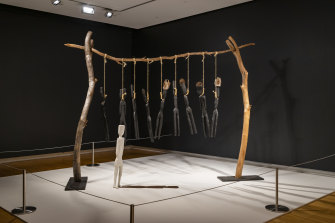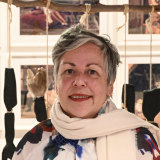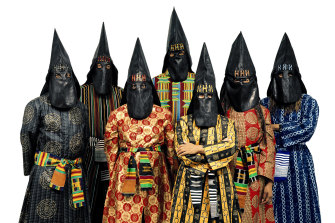
Nine black people are strung up, hanged by their necks, between two trees. For many Australians, such an image evokes the lynchings of the American south – what they don’t know is the same thing was done to Australian First Nations people during the frontier wars.

Fiona Foley’s Annihilation of the Blacks, 1986. wood, synthetic polymer paint, feathers, string, 204.5 x 267 x 85.7 cm, 13 parts. National Museum of Australia collection. Credit:Courtesy of the artist

Artist Fiona Foley in front of her works at McClelland Gallery.Credit:Natalie Tuck
It’s one of Fiona Foley’s early works, Annihilation of the Blacks, created in 1986 when she was at art school, and is part of the survey exhibition Fiona Foley: Veiled Paradise, at McClelland Gallery. Curated by Angelina Hurley at the QUT Art Museum, the show traces Foley’s career over nearly four decades, showing an extraordinary body of work, at times confronting, beautiful, unsettling and captivating.
The piece is simple and devastating, a reference to a massacre that happened on Foley’s Badtjala Country on the Maryborough River, the story passed down through oral history from her mother to her. Colonial soldiers at the time of the massacre would suspend bodies up in trees as a warning to Indigenous survivors. In the foreground, a single white figure casts a long shadow, reflecting the long-lasting trauma inflicted by these colonial actions. Foley says the sculpture is the first monument by an Aboriginal artist to honour an Aboriginal massacre in Australia.
Foley’s work never shies away from tough issues. With truth-telling at its heart, she also explores the beauty of her Country, Indigenous language, the use of opium in Queensland and slavery.
“They used to kidnap Aboriginal children and make them domestics, the pearling industry in Queensland was [founded on] kidnapping men, women and children,” she said. “People don’t take the time to read the history.”

Fiona Foley’s HHH (Hedonistic Honky Haters), was created in New York.Credit:QUT Art Collection
She has a huge interest in history and the frontier wars. “Associated with that is Aboriginal women’s sexuality and European men’s lust for Aboriginal women, historically,” she says.
Some of Foley’s best-known works are on display, including the striking photographic series HHH (Hedonistic Honky Haters), which draws parallels between American and Australian white supremacists and was created in New York.









 Add Category
Add Category